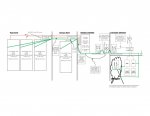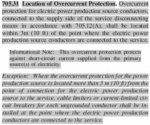You should really stop interjecting in every thread with the POCO requirements in your area
The OP's question was evidently about the AHJ interpretation of NEC requirements.
Thats rough, you have to build a garage to install a PV system.
I think you guys should stop interjecting this attitude that I'm a fool! This isn't a joke.
Two questions- why are there ATS switches in the diagram? And more importantly, why isn't there a PV disco in the basement?
Y'all are saying the code is confusing, and then giving me attitude for saying what I think the code might say.
Guess what- sometimes common sense helps. The OP's AHJ is wrong to say "move the outdoor disconnect to the basement".
Why? Well, what's missing then? The outdoor switch for the utility (and fire dept)! The fire dept would probably prefer it if the main house panels were also outdoors, but that certainly isn't required.
My personal opinion, based on nothing more than common sense, would be to move the fused switch *inside* the garage to the basement, and leave the switch outside the garage where it is, no fuse in outdoor switch.
Then you have a switch in the basement for any apprentice electrician who comes by to work on the house.
Trusting the homeowner to say "hey, there's 10,000w of PV out back", or trusting a random electrician (who may have never seen a PV system before) to read and obey some sign in the basement saying "go out to the garage to turn off the PV"...sounds very dangerous to me.
If you really want to get into code, 230.72(B) says "one additional remote" disconnect is allowed- that would be the one on the garage (or on a post. Whatever).
So the rest (including PV disconnect, which the outdoor switch is NOT) have to be grouped.
Makes sense to me, and is also what is described in the POCO example link I posted.
If this system in the diagram made a load side connection to the panel in basement, the panel breaker would be the PV disco- but you still want a PV disco next to the panel when the PV is line side.




